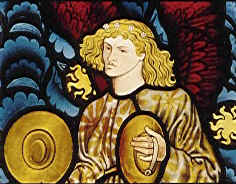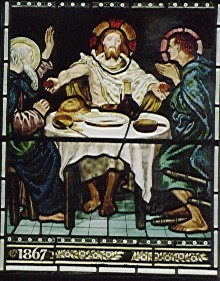|
The work of Morris, Madox Brown and Rossetti can be seen at All Saints,
Selsley near Stroud, the first church decorated by the firm. This
also has glass by Philip Webb who liked designing animals.
Middleton Cheney and nearby Banbury both have magnificent east windows from
the 1860s. Both have pairs of figures. At Middleton Cheney the
figures are by Morris, Madox Brown and by the Jewish artist, Simeon Solomon and
other windows are by Burne-Jones and Madox Brown. (These windows and those
at Selsley are described in Ann S. Dean's Burne-Jones and William
Morris.) This book also describes Burne-Jones's windows in Oxford.
In 1874 Morris took sole control of the firm, now officially named Morris and
Co. Morris now devoted all his attention to designing patterns and most of the
figures in the windows were designed by Burne-Jones.
Burne-Jones's Vyner Memorial Window
Windows by Morris, Burne-Jones and
Madox Brown at Brighton |

